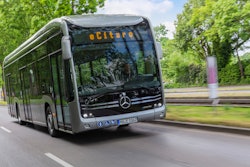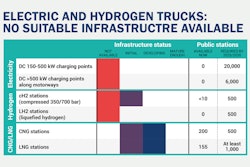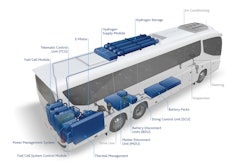On the occasion of the COP25 UN climate conference, the CEOs of Europe’s truck makers re-confirm their full commitment to help make the transition to carbon-neutral and zero-emission freight transport.
Gathering December 6 in Brussels for the Commercial Vehicle Board meeting of the European Automobile Manufacturers’ Association (ACEA), the industry chiefs stressed that this transition cannot happen without radical policy changes by the European Union and the governments of all member states.
Earlier this year, the EU adopted its first-ever CO2 standards for heavy-duty vehicles, which will apply in 2025 (-15%) and 2030 (-30%)[1]. These stringent CO2 targets oblige all manufacturers to focus on, and massively ramp up investments in, alternative powertrains. Indeed, a growing offer of low- and zero-emission trucks is already available today, and many more are in the pipeline for the near future.
Read more: New Carbon Dioxide Regulations for Europe
“When we look at the total fleet of transport operators today, it is clear that the market will need to be completely turned around in an extremely short timeframe,” stressed Gerrit Marx, Chairman of ACEA’s Commercial Vehicle Board and President of CNH Industrial Commercial Vehicles and Speciality.
Brand new data released by ACEA shows that 98.3% of all heavy and medium trucks (above 3.5 tonnes) on Europe’s roads today run on diesel. Electrically-chargeable vehicles account for a negligible share of all trucks in circulation (0.01%, or one out of every 10,000 vehicles), and around 0.4% of all trucks in the EU run on natural gas.
“If we are to transform this startling picture and convince hauliers to make the switch to low- and zero-emission vehicles on a large-scale, Europe urgently needs to introduce a strong package of consistent and predictable policy measures,” Marx urged EU policy and decision makers.
This includes for instance the rapid roll-out of dedicated charging and refuelling infrastructure for trucks – which is completely absent today – and putting in place meaningful incentives to make these vehicles a commercially-viable and competitive choice for transport operators, thereby fostering fleet renewal.
The revision of the Eurovignette Directive should also allow for the differentiation of road user charges by CO2 emissions. “Member states in particular need to step up to the game in all these areas,” said Marx.
“Creating real market demand for low- and zero-emission vehicles should now be the priority. Binding sales quotas for manufacturers, on the other hand, would not do anything to encourage transport companies to purchase alternatively-powered trucks.”
Marx said, “In order to create a business environment where carbon-neutral solutions are the preferred option, all stakeholders will have to work together to transform the entire value chain of transport.”
According to ACEA’s new report, ‘Vehicles in Use - Europe 2019’, there are 6.6 million trucks on the EU’s roads. With more than 1.1 million trucks, Poland has the largest truck fleet in the EU, followed closely by Germany and Italy. The report also shows that the EU truck fleet is aging rapidly. Trucks are now on average 12.4 years old in the European Union, compared to 11.7 years in 2013.
[1] The 2019/2020 baseline for the 2025 and 2030 CO2 reduction targets is still unknown.



















